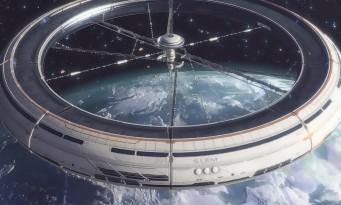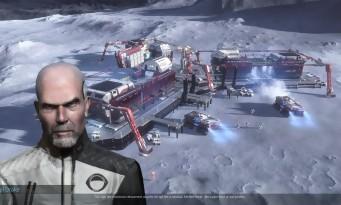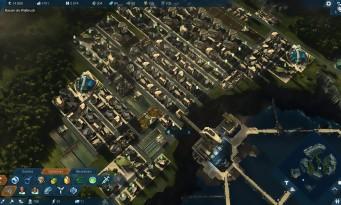 Forget the climate and pollution issues of Anno 2070, because this new episode is more utopian than dystopian. In 2205, the goal of the various world corporations is quite simply to colonize the Moon, in order to build fusion reactors capable of covering the energy needs of the Earth. A task that can only be carried out in three immutable steps: take possession of a land area located in a temperate climate, then develop on the Arctic continent, before finally being able to walk on the moon. The set-in-stone character of the process comes from a bold design choice: the game features a unique campaign, which serves as both a story-driven single-player mode and an endless mode. A concept that is not uninteresting, but which may offend a lot of fans of the series. It still happens that this way of doing things turns out to be more dirigiste than in the past. But it is frankly regrettable that, suddenly, the new Anno completely ignores independent scenarios, randomly generated maps or even any multiplayer mode. Fortunately, the change of scenery provided by the futuristic universe and the effectiveness of the gameplay largely compensate for these shortcomings which, otherwise, would have been unforgivable. In 2205, we no longer harvest wood and we no longer produce simple diamonds.
Forget the climate and pollution issues of Anno 2070, because this new episode is more utopian than dystopian. In 2205, the goal of the various world corporations is quite simply to colonize the Moon, in order to build fusion reactors capable of covering the energy needs of the Earth. A task that can only be carried out in three immutable steps: take possession of a land area located in a temperate climate, then develop on the Arctic continent, before finally being able to walk on the moon. The set-in-stone character of the process comes from a bold design choice: the game features a unique campaign, which serves as both a story-driven single-player mode and an endless mode. A concept that is not uninteresting, but which may offend a lot of fans of the series. It still happens that this way of doing things turns out to be more dirigiste than in the past. But it is frankly regrettable that, suddenly, the new Anno completely ignores independent scenarios, randomly generated maps or even any multiplayer mode. Fortunately, the change of scenery provided by the futuristic universe and the effectiveness of the gameplay largely compensate for these shortcomings which, otherwise, would have been unforgivable. In 2205, we no longer harvest wood and we no longer produce simple diamonds.  Organic food, construction robots, rejuvenators, neural implants, iridium, graphene and other titanium veneers are now your daily life. But this change of herbage is nothing compared to the real revolution wrought by Anno 2205: the "multi-session" gameplay. This somewhat pompous term roughly means that in the same game, different colonies are built in parallel, on separate maps. A strategic view allows you to quickly take a look at the different regions currently conquered and, of course, to switch from one to another at leisure. With loading times which we would have gladly done without... But the power of our machines is not infinite, it is a necessary evil. On the other hand, whatever the map on which we happens, the others continue to run in parallel, and therefore provide resources. Conversely, a badly done production chain can completely collapse in a given region, even though we are busy in another.
Organic food, construction robots, rejuvenators, neural implants, iridium, graphene and other titanium veneers are now your daily life. But this change of herbage is nothing compared to the real revolution wrought by Anno 2205: the "multi-session" gameplay. This somewhat pompous term roughly means that in the same game, different colonies are built in parallel, on separate maps. A strategic view allows you to quickly take a look at the different regions currently conquered and, of course, to switch from one to another at leisure. With loading times which we would have gladly done without... But the power of our machines is not infinite, it is a necessary evil. On the other hand, whatever the map on which we happens, the others continue to run in parallel, and therefore provide resources. Conversely, a badly done production chain can completely collapse in a given region, even though we are busy in another.
IN THE MOONLIGHT
 This real-time management of different maps naturally makes it possible to establish trade routes between different regions, including lunar ones. On the other hand, the maps in question are fixed (no random generation, as seen previously) and in relatively small numbers (three for each geographical area, therefore nine). To this must be added two very specific maps, which correspond to crisis sectors. This term designates the regions where military clashes take place. The combat phases have always been a little wonky in the various episodes of the Anno saga, and it's rather a good thing to have separated them from the main gameplay, because they thus become optional. At least in theory because, in practice, going to the crisis sectors to complete these secondary missions remains the most efficient way to access the rarest resources, which are then offered to us as a reward. Concretely, these crisis sectors put us in command of a few ships which, like an RTS, must sink enemy units, destroy some buildings and even pick up resources scattered on the water in order to be able to trigger special powers. Nothing transcendent in all this, and these phases must be considered as simple interludes which bring a little variety to the gameplay. But the heart of the game remains of course the creation of self-sufficient colonies, through the construction of various buildings and the establishment of production chains necessary to create the goods demanded by ever more demanding inhabitants. However, this episode differs from previous Anno in several points. First of all, the gameplay evolves according to the geographical area played. While the maps located in a temperate climate are managed in a relatively conventional way, those of the Arctic region require you to take heat constraints into account. In order not to suffer excessively from the cold, your homes must imperatively be placed near the production buildings, the heat they give off being diffused within a certain radius. A concept that goes against what is usually done in most management games, factories are generally considered to be sources of nuisance.
This real-time management of different maps naturally makes it possible to establish trade routes between different regions, including lunar ones. On the other hand, the maps in question are fixed (no random generation, as seen previously) and in relatively small numbers (three for each geographical area, therefore nine). To this must be added two very specific maps, which correspond to crisis sectors. This term designates the regions where military clashes take place. The combat phases have always been a little wonky in the various episodes of the Anno saga, and it's rather a good thing to have separated them from the main gameplay, because they thus become optional. At least in theory because, in practice, going to the crisis sectors to complete these secondary missions remains the most efficient way to access the rarest resources, which are then offered to us as a reward. Concretely, these crisis sectors put us in command of a few ships which, like an RTS, must sink enemy units, destroy some buildings and even pick up resources scattered on the water in order to be able to trigger special powers. Nothing transcendent in all this, and these phases must be considered as simple interludes which bring a little variety to the gameplay. But the heart of the game remains of course the creation of self-sufficient colonies, through the construction of various buildings and the establishment of production chains necessary to create the goods demanded by ever more demanding inhabitants. However, this episode differs from previous Anno in several points. First of all, the gameplay evolves according to the geographical area played. While the maps located in a temperate climate are managed in a relatively conventional way, those of the Arctic region require you to take heat constraints into account. In order not to suffer excessively from the cold, your homes must imperatively be placed near the production buildings, the heat they give off being diffused within a certain radius. A concept that goes against what is usually done in most management games, factories are generally considered to be sources of nuisance.
THE BLOODER OF THE ANNO?
 As for the lunar gameplay, it requires placing shield generators at regular intervals, which protect buildings from falling meteorites. Note in passing that in order to recreate the typical island gameplay of the series, the lunar bases must imperatively be built inside the craters, which therefore act as inverted islands. Beyond regional specificities, Anno 2205 now offers modular production buildings. It is thus possible to increase the production of a given building, reduce energy consumption, reduce the need for labor or even add storage space, by simply building the appropriate additional modules. If you ever run out of space for this, know that it is now possible to move buildings that have already been constructed at will. A very practical but unrealistic feature, which goes in the direction of a general simplification of the gameplay, which purists will find a little too much. Thus, logistics is considered as a simple resource, and it is therefore no longer really a question of optimizing the routing of transport vehicles. It is also no longer possible to change the amount of taxes, which have simply disappeared. And the flow of resources is now immediate, not incremental. No sooner is a building placed than its full and complete effect immediately appears in the figures. All this means that we reach the stage of lunar construction quite easily and quickly. But rest assured, it remains long and relatively complex to develop a viable lunar base over the long term. Finally, let's finish with a word about the graphics, which are extremely pleasant. The futuro-spatial art direction is in good taste, while the postcard mode and certain camera movements allow you to take advantage of an advanced graphics engine. And of course, zooming in on our colonies to observe the life that takes place there is a real pleasure, especially on the Moon where we can see our astronauts perform small leaps due to reduced gravity. Enough to give a smile to all players, whether they are novices or regulars in the series.
As for the lunar gameplay, it requires placing shield generators at regular intervals, which protect buildings from falling meteorites. Note in passing that in order to recreate the typical island gameplay of the series, the lunar bases must imperatively be built inside the craters, which therefore act as inverted islands. Beyond regional specificities, Anno 2205 now offers modular production buildings. It is thus possible to increase the production of a given building, reduce energy consumption, reduce the need for labor or even add storage space, by simply building the appropriate additional modules. If you ever run out of space for this, know that it is now possible to move buildings that have already been constructed at will. A very practical but unrealistic feature, which goes in the direction of a general simplification of the gameplay, which purists will find a little too much. Thus, logistics is considered as a simple resource, and it is therefore no longer really a question of optimizing the routing of transport vehicles. It is also no longer possible to change the amount of taxes, which have simply disappeared. And the flow of resources is now immediate, not incremental. No sooner is a building placed than its full and complete effect immediately appears in the figures. All this means that we reach the stage of lunar construction quite easily and quickly. But rest assured, it remains long and relatively complex to develop a viable lunar base over the long term. Finally, let's finish with a word about the graphics, which are extremely pleasant. The futuro-spatial art direction is in good taste, while the postcard mode and certain camera movements allow you to take advantage of an advanced graphics engine. And of course, zooming in on our colonies to observe the life that takes place there is a real pleasure, especially on the Moon where we can see our astronauts perform small leaps due to reduced gravity. Enough to give a smile to all players, whether they are novices or regulars in the series.


























